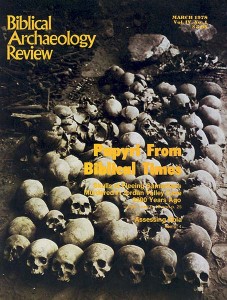Biblical Archaeology Review, March 1978
Features
Leading Scholar Calls for Prompt Publication
How quickly should ancient texts be published after they come into a scholar’s hands? Within one year—at most, says Professor David Noel Freedman in a forthcoming issue of the Biblical Archaeologist. This is a statement of major importance by one of the world’s leading Biblical scholars—a statement...Read more ›
Assessing Ebla
No archaeological find since the Dead Sea Scrolls has so excited the public imagination as the recently-discovered and already famous Ebla tablets. Newspapers like the New York Times, Los Angeles Times and Washington Post, national magazines like Time and Newsweek, archaeological journals like the Biblical Archaeologist and...Read more ›
The Name of God in the New Testament
Did the earliest Gospels use Hebrew letters for the Tetragrammaton?
Many early copies of the New Testament abbreviate sacred words (nomina sacra). The earliest of these abbreviations stand for “God,” “Lord,” “Christ,” and “Jesus.” Abbreviations of these words were formed by writing their first and last letters and placing a line over them. Thus, using English to...Read more ›
Bedouin Find Papyri Three Centuries Older Than Dead Sea Scrolls
Subsequent excavations in bat dung by American archaeologist confirms original location of the papyrus scrolls; diggers find hundreds of additional small fragments in Jordan Valley caves.
Nineteen-sixty-one was the third winter of drought. In the Old City of Jerusalem there were long queues at the water spigots. Tribes of Ta‘âmireh bedouin were drifting north past Jerusalem. Whole families and clans were moving together, at times afoot, at times by donkey train with an...Read more ›
The Historical Importance of the Samaria Papyri
When the Ta‘âmireh bedouin penetrated the Daliyeh cave (as described in the previous article by Paul Lapp) they found within more than 300 skeletons lying on or covered by mats. The bones were mixed with fragments of manuscripts. These manuscripts were not burial documents, but everyday business...Read more ›
BAR Preservation Fund Goes to Work
BAR’s readers will preserve Herodian Jericho, place signs at Biblical Lachish, and support preservation research. Based on early contributions to its Archaeological Preservation Fund, BAR has committed its readers to a three-pronged preservation effort. • BAR will provide funds to preserve—and possibly restore—the magnificent winter palaces of...Read more ›
The Holy Land in Coins
What archaeologists find is important. But what they don’t find can be just as important—such as their failure to find coins anywhere in the world before the end of the 7th century B.C. In the Holy Land, coins are not found until about 100 years later. This...Read more ›
Invitation to a Summer's Dig
As in years past summer is the time for old hands and new adventurers—young and not so young—to join archaeological excavations in the Holy Land. There are many opportunities in 1978, some of which offer academic credit for the work-study of the summer. Tel Aviv University, Institute...Read more ›
Ancient City of David To Be Re-Excavated
A major new excavation will begin this summer in the oldest inhabited part of Jerusalem. Known as the city of David, the site is located on a dusty ridge south of the present Old City. The following article is by the man who is responsible for initiating...Read more ›
Israel's Archaeological Gifts to Egyptian President Anwar Sadat
Sadat receives oil flasks from Patriarchal times and lamps from the time of the Maccabees.
The exchange of gifts between Israeli and Egyptian Heads of State has a history dating back to Biblical peace treaties between Egyptian Pharaohs and Israelite Kings. 1 Kings 9:15–17 describes such an exchange between King Solomon and an Egyptian Pharaoh (either Siamun or Shishak...Read more ›

